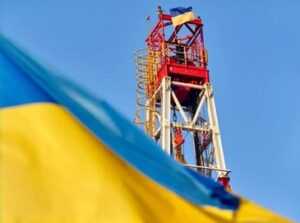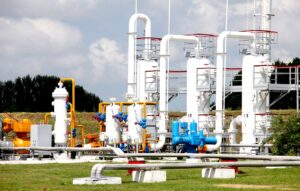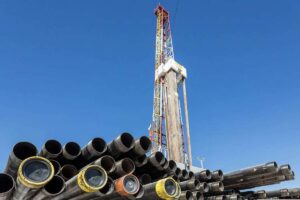
In 2023, Naftogaz Group increased production from workover wells by 20% compared to pre-war 2021, which was a record high for the last four years.
“This figure is 20% higher than production in pre-war 2021. I am sincerely grateful to the specialists of Ukrgazvydobuvannya and the entire team that made this result possible,” the group said on its website, citing Naftogaz CEO Oleksiy Chernyshev on Thursday.
Recently, Ukrgasvydobuvannya JSC (UGV), a part of the Naftogaz group, has overhauled and restored an old well, which now additionally produces more than 340 thousand cubic meters of gas per day.
This well had been awaiting abandonment for a long time, but in 2023, experts conducted a detailed analysis, reviewed technical and geological risks, and decided to restore the well through workovers.
“Our experts are constantly working on reviewing and analyzing old wells that can be brought back into operation due to better technical capabilities than decades ago,” commented Oleh Tolmachov, Acting CEO of Ukrgasvydobuvannya.
As reported, in 2022, Ukrgasvydobuvannya produced 12.5 bcm of natural gas (commercial), which is 3% less than in 2021. According to operational data, the company increased production by more than 0.7 bcm in 2023.
NJSC Naftogaz of Ukraine owns 100% of Ukrgasvydobuvannya shares.

In January 2024, PJSC Ukrnafta increased oil and condensate production by 0.2% (by 0.27 ktonnes) compared to January last year to 121.08 ktonnes, and gas production by 8.3% (by 7.77 mcm) to 100.91 mcm.
According to the company’s press release, the total production in oil equivalent of hydrocarbons amounted to 207.87 ktonnes, which is 3.5% more than in January 2023 (200.92 ktonnes).
“I am grateful to the company’s specialists who continue to increase the production of Ukrainian resources for the second year in a row. We continue to drill new wells, implement production stimulation measures and upgrade old equipment to API standards,” Ukrnafta CEO Serhiy Koretsky said in a statement.
As reported, in 2023, Ukrnafta increased oil and condensate production by 3% (by 39.9 thousand tons) compared to 2022 – up to 1 million 409.9 thousand tons, gas production – by 5.8% (by 60.4 million cubic meters), up to 1 billion 97.4 million cubic meters.
“Ukrnafta’s strategic goal is to double its oil and natural gas production to 3 million tons and 2 billion cubic meters by 2027, respectively.
“Ukrnafta is Ukraine’s largest oil producer and operator of a national network of 537 filling stations, of which 456 are in operation.
Ukrnafta’s largest shareholder is Naftogaz of Ukraine with a 50%+1 share. On November 5, 2022, the Supreme Commander-in-Chief of the Armed Forces of Ukraine decided to transfer the corporate rights of the company owned by private owners, which is now managed by the Ministry of Defense, to the state.
condensate, GAS, OIL, UKRNAFTA

PJSC Ukrnafta has increased its reserves by 330 thousand tons of oil and 618 million cubic meters of gas by expanding the boundaries of two existing special permits, the company’s press service reports.
According to the company, the reason for expanding the boundaries of the special permits is to bring their size to the contours of the field’s productive deposits.
The subsoil area of the first special permit now amounts to 18.33 square kilometers, which is 23.1% more than the previously granted area. Total reserves increased by 217 thousand tons of oil and condensate and 232 million cubic meters of gas.
The area of the second license increased by 16.3% to 41.75 square kilometers. Total reserves increased by 113 thousand tons of condensate and 386 million cubic meters of gas.
“By 2023, the company has expanded the boundaries of special permits only twice. I thank the company’s employees who prepared and submitted the necessary applications and packages of documents to the State Service of Geology and Subsoil of Ukraine, after which the relevant orders were received, thus increasing the opportunities for resource extraction,” said Sergiy Koretsky, CEO of Ukrnafta.
As reported, in 2023, Ukrnafta increased oil and condensate production by 3% (by 39.9 thousand tons) compared to 2022 – up to 1 million 409.9 thousand tons, gas production by 5.8% (by 60.4 million cubic meters), up to 1 billion 97.4 million cubic meters.
“Ukrnafta’s strategic goal is to double its oil and natural gas production to 3 million tons and 2 billion cubic meters by 2027, respectively.
“Ukrnafta is Ukraine’s largest oil producer and operator of a national network of 537 filling stations, of which 456 are in operation.
Ukrnafta’s largest shareholder is Naftogaz of Ukraine with a 50%+1 share. On November 5, 2022, the Supreme Commander-in-Chief of the Armed Forces of Ukraine decided to transfer the corporate rights of the company owned by private owners, which is now managed by the Ministry of Defense, to the state.

Ukrtransgaz plans to invest UAH 998.277 million in the development of natural gas storage facilities in 2024 in accordance with the gas storage development plan for 2024-2033 approved by the National Energy and Utilities Regulatory Commission (NEURC) at a meeting on Tuesday.
“We are moving towards 100% fulfillment of investment programs in general,” said Roman Malyutin, Ukrtransgaz CEO, at the meeting.
According to him, the approved plan provides for the reconstruction and construction of fixed assets of technological processes in the gas storage system, the development of critical infrastructure security facilities, including cybersecurity, and information technology.
According to the document, the company intends to invest UAH 472.355 million this year in the operation of gas storage facilities, UAH 415.988 million in the development of underground gas storage facilities, UAH 66.442 million in the modernization and purchase of vehicles, special machines and mechanisms, UAH 27.413 million in the purchase of diagnostic and inspection equipment and other devices, and UAH 16.079 million in industrial and administrative buildings.
In total, Ukrtransgaz’s gas storage development plan for 2024-2033 envisages an investment of UAH 14 billion 534.148 million.

The Government of Ukraine has maintained zero quotas for the export of natural gas of Ukrainian origin, edible salt, anthracite, coal and coal briquettes, gold, silver, as well as precious metal waste and scrap for 2024.
The Cabinet of Ministers published Resolution No. 1402 of December 27 on the list of goods subject to licensing on its website.
According to the resolution, the quotas for the export of liquid fuel (fuel oil), which were in effect in 2023, were preserved – 540 thousand tons (no more than 60 thousand tons per month) and coking coal – 900 thousand tons.
In addition, the government has extended the ban on the export of fuel wood, wood chips or shavings for January-February 2023, after which the export of these goods will be removed from the list of licensed goods.
The licensing of wheat, rye, barley, oats, corn, soybeans, rapeseed and sunflower seeds, soybean, rapeseed, sunflower and mustard oil, and oilcake has also been retained.
ANTHRACITE, BAN, EXPORT, GAS, SALT

Naftogaz Group has increased gas production by more than 400 thousand cubic meters by launching three wells in November, its CEO Oleksiy Chernyshov said.
“We continue to increase Ukrainian gas production! In November alone, three high-rate wells were put into operation (…). In total, in November we have an additional 400 thousand cubic meters of gas per day!” he wrote on his Facebook page on Friday.
Chernyshov clarified that two of the mentioned wells are new. Their launch was the result of the implementation of the largest 3D seismic survey program in the history of modern Ukraine and the high professionalism of Naftogaz specialists. The third well is a rehabilitated well that had been in the liquidation fund for 35 years.
As reported, in 2023, Ukrgasvydobuvannya set a goal to increase natural gas production by 1 billion cubic meters to 13.5 billion cubic meters. In 2022, the company produced 12.5 bcm of natural gas (commercial), which is 3% less than in 2021.
NJSC Naftogaz of Ukraine owns 100% of Ukrgasvydobuvannya shares.